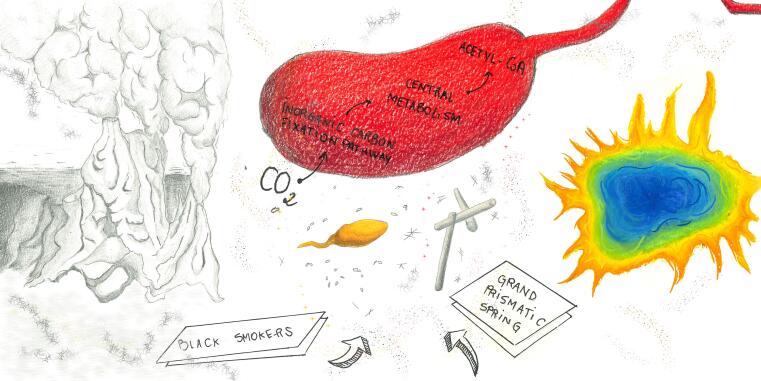Research


The recently described ammonia-oxidizing archaea of the phylum Thaumarchaeota are highly abundant in marine, geothermal, and terrestrial environments. All characterized representatives of this phylum are aerobic chemolithoautotrophic ammonia oxidizers assimilating inorganic carbon via a recently described thaumarchaeal version of the 3-hydroxypropionate/4-hydroxybutyrate cycle. The thaumarchaeal variant of the hydroxypropionate/hydroxybutyrate cycle requires less ATP than any other aerobic autotrophic carbon fixation cycle. High efficiency of anabolism exemplified by this autotrophic cycle perfectly suits the lifestyle of ammonia-oxidizing archaea, thriving at constantly low energy supplies, thus offering biochemical explanation for their ecological success. Although some genes coding for the enzymes of this cycle have been identified in the genomes of Thaumarchaeota, many other genes of the cycle are not homologous to the characterized enzymes from other species and can therefore not be identified bioinformatically. Our goal is their identification and biochemical characterization.
At least six different autotrophic pathways are involved in primary production, and further pathways are still awaiting their description. Thermophilic microorganisms developing at high temperatures are represented by various (including the most ancient) phylogenetic groups among bacteria and archaea. Thermophiles are characterized by an extraordinary variety of biochemical mechanisms — both of catabolic reactions, allowing the use of an unusually wide range of electron donors and acceptors, and of anabolic pathways responsible for assimilation of inorganic carbon. Here, we investigate the diversity of autotrophic CO2 fixation mechanisms in different thermophilic bacteria. Our data show that A. degensii and T. narugense use a modified version of the Calvin-Benson cycle of inorganic carbon fixation, while D. acetivorans and H. maritima use an unusual variant of the reductive tricarboxylic acid cycle with citrate synthase operating in the reverse direction.
https://science.sciencemag.org/content/359/6375/563.abstract
Whereas aerobic autotrophic Crenarchaeota (Sulfolobales) use the 3-hydroxypropionate/4-hydroxybutyrate cycle for inorganic carbon fixation, anaerobic Crenarchaeota of the orders Thermoproteales and Desulfurococcales use the dicarboxylate/4-hydroxybutyrate cycle. These two pathways use different carboxylases to synthesize succinyl-CoA from acetyl-CoA but share the reactions of acetyl-CoA regeneration from succinyl-CoA via 4-hydroxybutyrate and have probably common evolutionary routes. These pathways were discovered in Metallosphaera sedula (Sulfolobales) and Ignicoccus hospitalis (Desulfurococcales) only recently (2007 and 2008, respectively), and many enzymes of the pathways were not yet identified and biochemically characterized. Furthermore, I. hospitalis is an extraordinary organism possessing two membranes, an inner and an energized outer membrane, and subcellular localization of enzymes involved in autotrophic CO2 fixation is an intriguing but not yet explored question. Some Pyrobaculum species were described to be capable to grow autotrophically but did not possess key genes of both 4-hydroxybutyrate cycles in their genomes, and there pathway of CO2 fixation is not known.
https://www.nature.com/articles/nrmicro2365
https://www.frontiersin.org/articles/10.3389/fmicb.2020.00354/full
Itaconate (methylene succinate) is an immune metabolite produced by activated tissue culture macrophages. It impairs the central carbon metabolism of several pathogens and affects their metabolism and growth. Itaconate is also known as a product of soil fungi, and its degradation is also a common feature of soil bacteria. We study aerobic and anaerobic pathways of itaconate utilization and their distribution, in particular in anaerobic bacteria.
The function of many proteins encoded in the genomes is unknown even for best studied model organisms like Corynebacterium glutamicum, Pseudomonas aeruginosa or Salmonella enterica. Using purified proteins, we have recently shown that a citrate lyase β-subunit-like (CitE-like) protein in Yersinia pestis and P. aeruginosa functions as (S)-citramalyl-CoA lyase in itaconate metabolism. Our results revealed the connection of itaconate degradation to pathogenicity and suggested that itaconate degradation can be regarded as a persistence factor in various pathogens. Furthermore, other members of this class are involved in acetate assimilation in bacteria (ethylmalonyl-CoA pathway) and haloarchaea (methylaspartate cycle), autotrophic CO2 fixation (3-hydroxypropionate bi-cycle) and other metabolic processes. Here, we study properties of uncharacterized members of the family of CitE-like proteins and their functions.